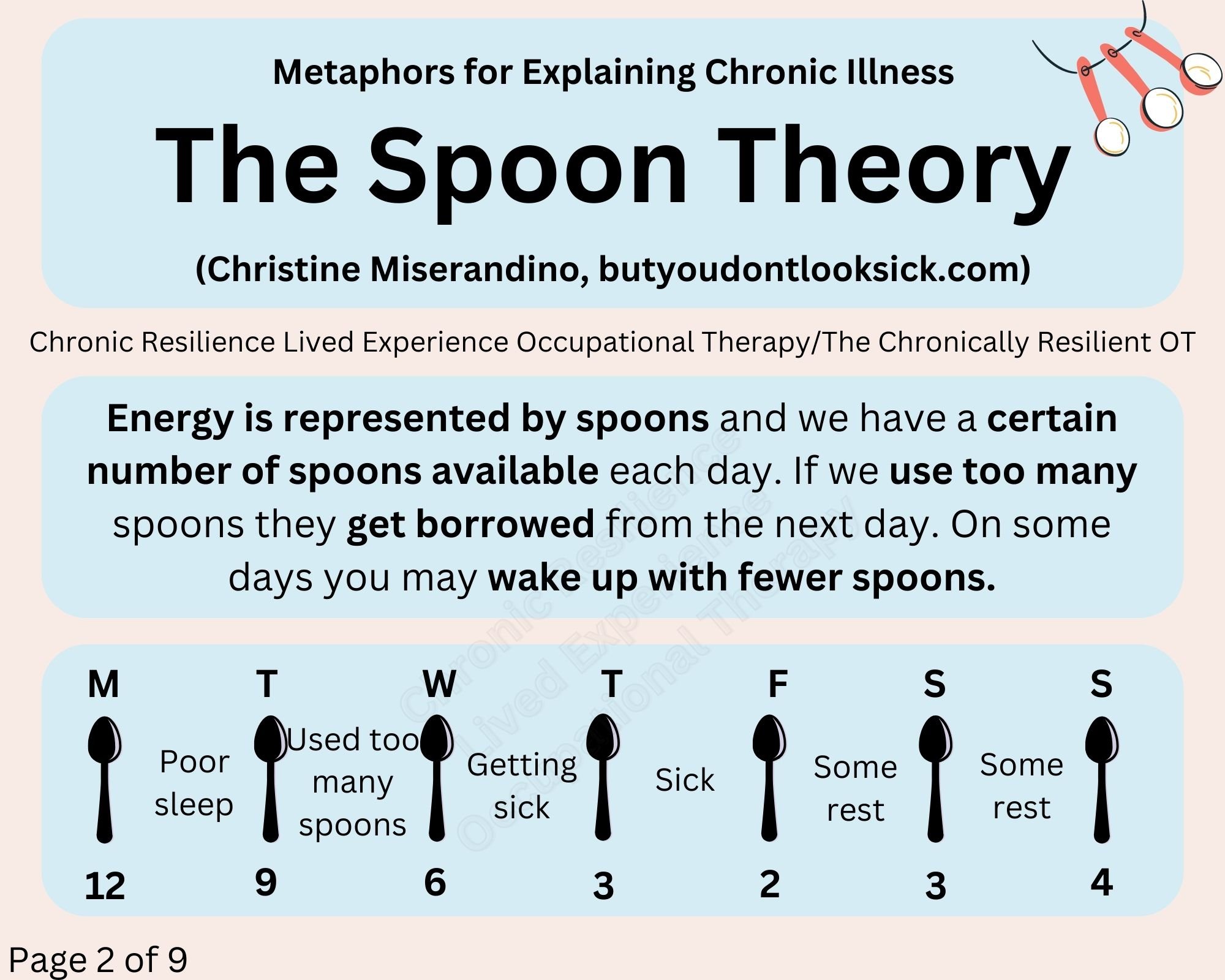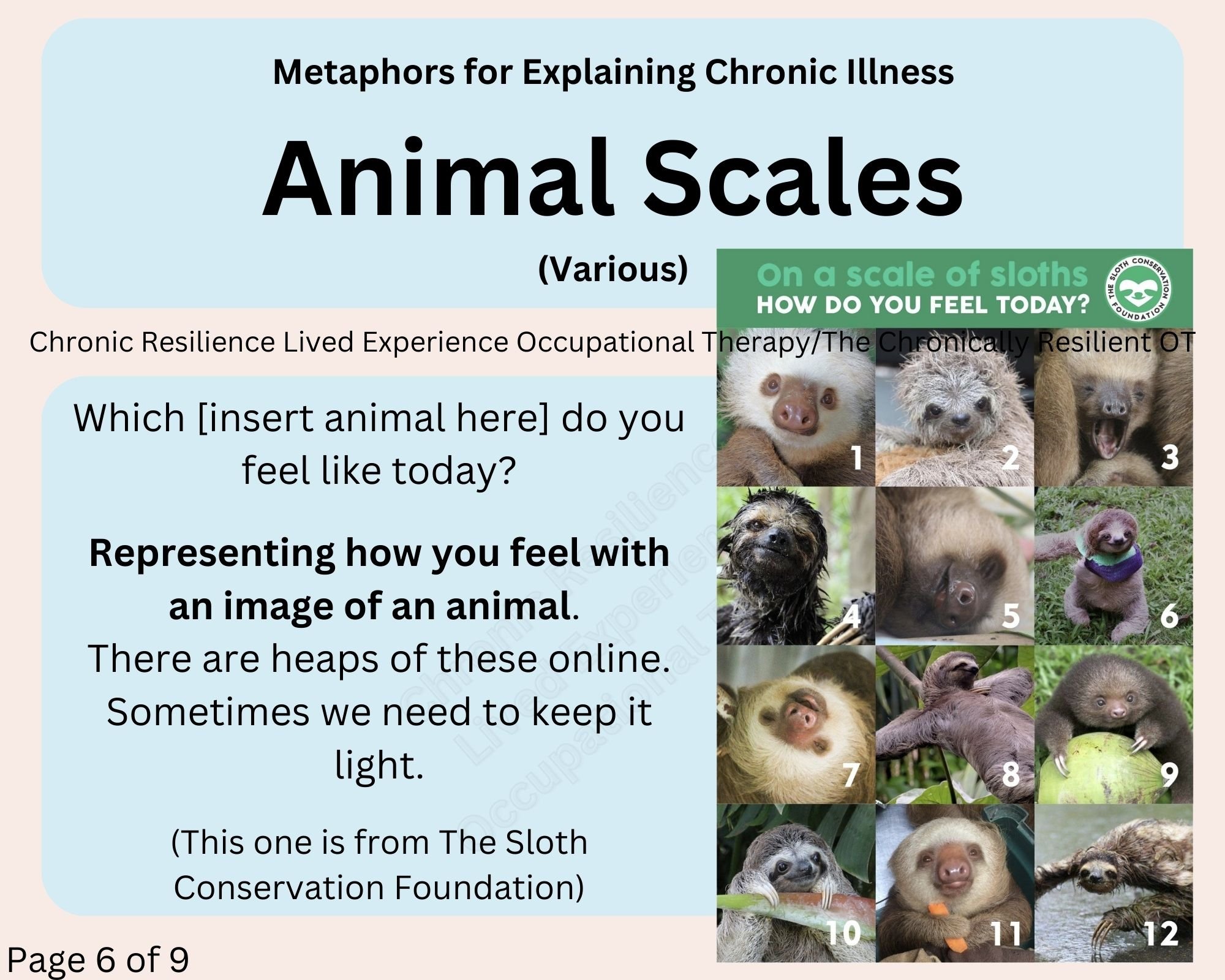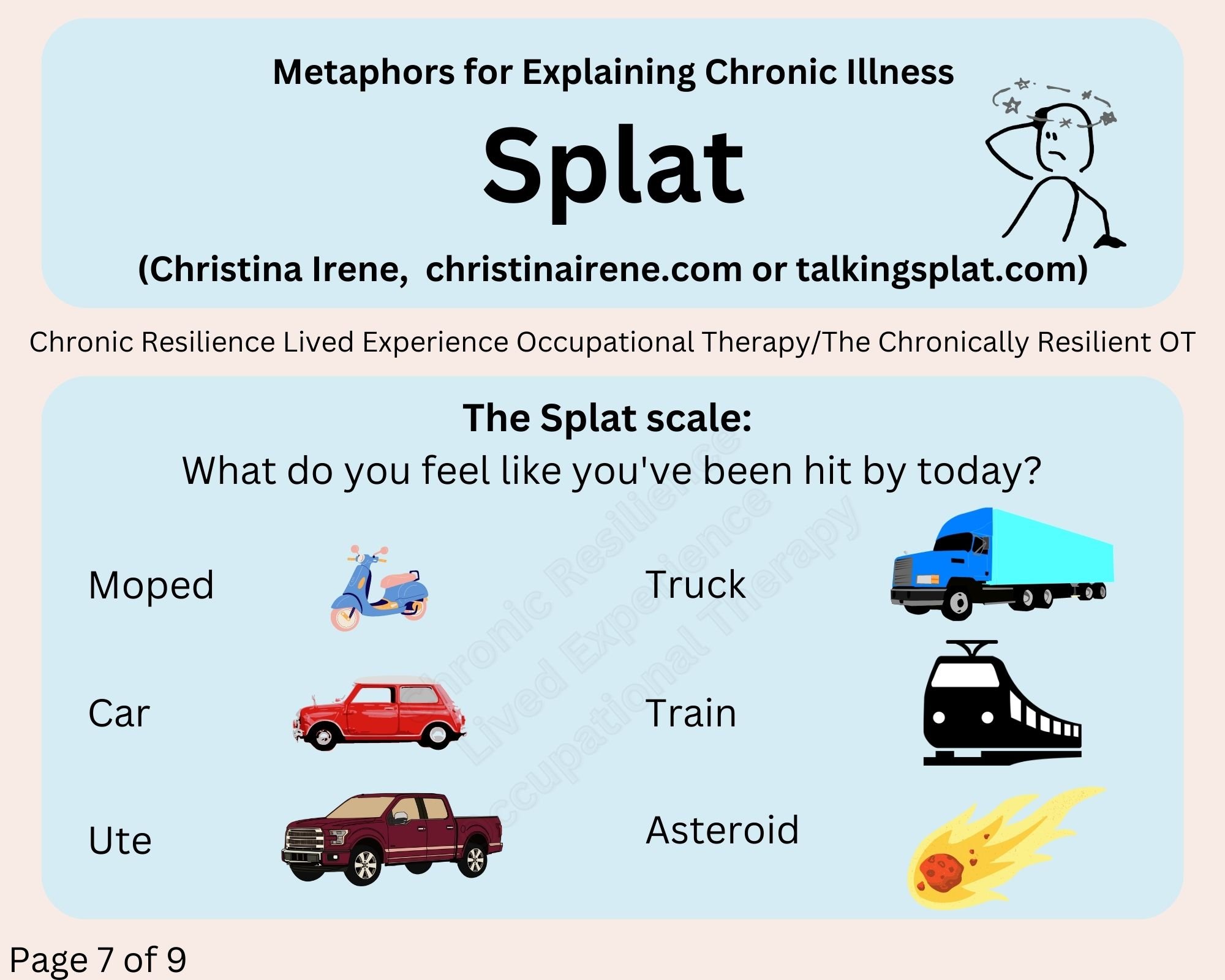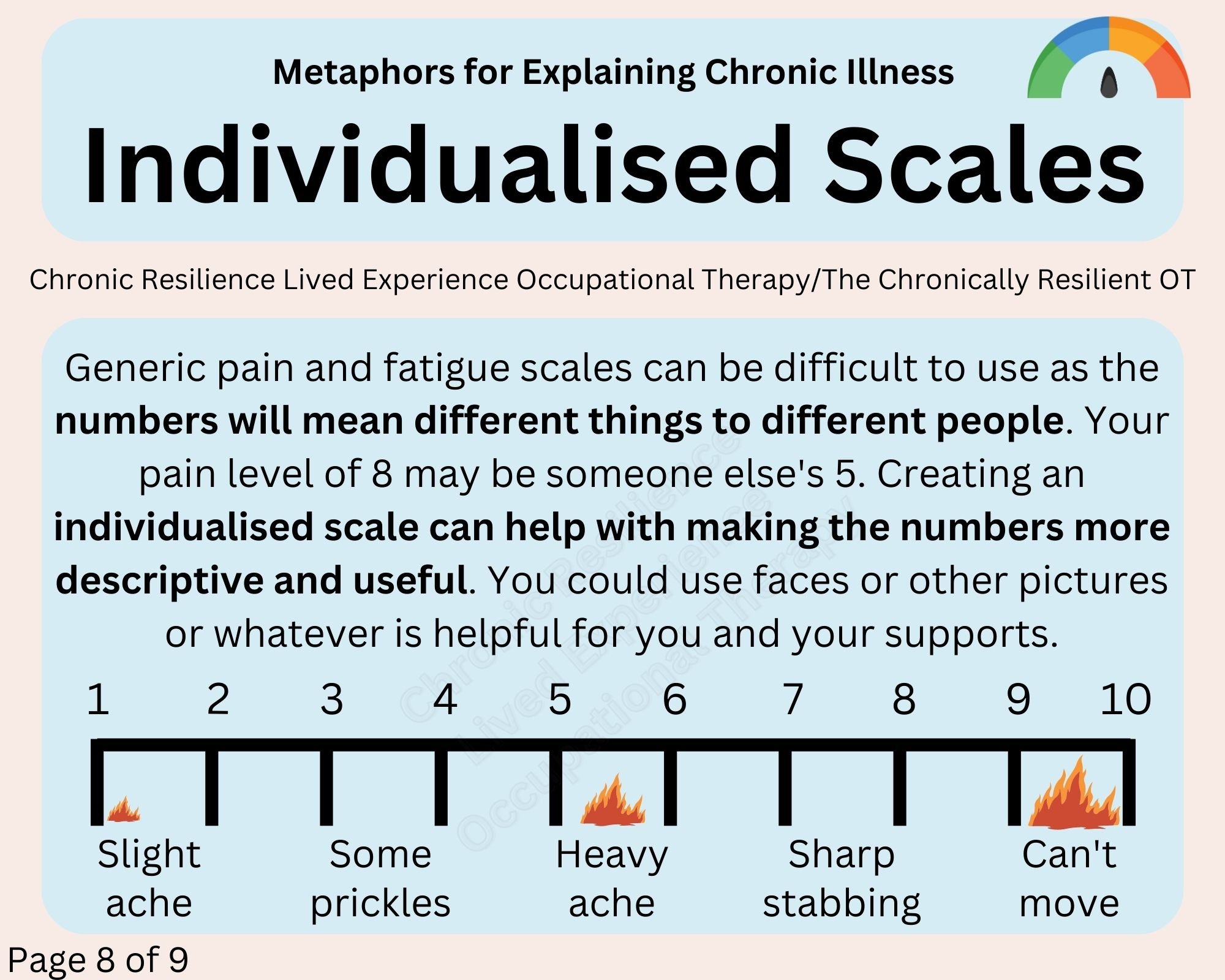Metaphors for Explaining Chronic Illness
(Can also apply to mental illness and other neurodivergence)
Explaining the reality of the chronic illness experience to someone who doesn't live it can be really challenging and there are some great metaphors out there that can help.
I’ve created a graphic series outlining a few of them, including:
Spoon Theory (Christine Miserandino, 2003)
Forks (Jen Rose, 2018)
Oxygen Tank (a previous psychologist of mine)
Animal Scales (various memes online)
Splat (Christina Irene, 2019)
In a previous graphic I discussed the idea of different sized sensory jars and have included this here as well.
Spoon Theory (Christine Miserandino, 2003)
This is probably the most well-known one and it has been around for a while. Again it is trying to break down something very complex into a simple representation of spoons for energy, so it can’t possible cover all bases. This seems to be a good starting point for people for understanding their own limits and for communicating them to others.
It’s important to note that we don’t all wake up with the same number of spoons each day, spoons don’t necessarily replenish overnight and sometimes it’s not possible to stick to your spoon limit, which borrows from the next day and when this keeps going we just keep borrowing, which can lead to burnout.
Different activities take different numbers of spoons, which will differ person to person, and even for the same person on different days.
Sometimes it’s helpful to think in more general terms like low spoon or high spoon days, instead of a specific number. If you wake up and you know it’s a low spoon day, what’s your plan? How do things change for you? That is not the time to be making decisions, so it can be good to have a plan ahead of time.
Image description: graphic with brown background, blue boxes and black text. Heading ‘The Spoon Theory’, credit to Christine Miserandino. Energy is represented by spoons and we have a certain number of spoons available each day. If we use too many spoons they get borrowed from the next day. On some days you may wake up with fewer spoons. 7 spoons represent different days of the week with a changing number of spoons available based on different factors.
Image description: graphic with brown background, blue boxes and black text. Heading ‘The Spoon Theory’, credit to Christine Miserandino. Different activities take different numbers of spoons. What is 1 spoon for you might be 4 for someone else (can also change day to day for yourself). Different examples of 1, 2, 3 and 4 spoon activities.
Forks (Jen Rose, 2018)
Like the proverb ‘the straw that broke the camel’s back’. It’s not the final thing that takes you over the limit that’s the issue, it’s all the other things you were ignoring that have built up and then a seemingly small thing pokes in and it’s all over. I had this happen once when the Xbox tray wouldn’t open and I burst into tears. It wasn’t the tray not opening that was the issue really, but it was the final fork that caused overwhelm when I was already vulnerable and overwhelmed. Forks might be different on different days, and to some extent you might be able to ignore a couple of them, but it’s important to notice any early warning signs and address things before hitting overload when you can (e.g. have a snack, go to the toilet, go somewhere quieter). Sometimes we don’t know the early warning signs or it might be difficult to address things, do the best you can, self-criticism doesn’t need to be another fork!
Image description: graphic with brown background, blue boxes and black text. Heading ‘Fork Theory’, credit to Jen Rose. Everyone has limit to the number of forks they can tolerate being stuck in them. At a certain number it is no longer possible to ignore the forks and one additional fork can result in overwhelm/shutdown/ meltdown. There is an image of a person with their brain exploding and 6 forks around them representing: new symptom, hungry, need to pee, high pain day, itchy, tag, ableist comment.
Oxygen Tank
This is one I’ve used personally for a while for my own understanding and compassion more than anything else. It was introduced by a psychologist I was working with many years ago. Understanding that my tank had holes in it and so drained faster than other people’s, really helped me to be more gentle with my expectations of myself. That’s still a work in progress, but this has been a useful concept to keep coming back to.
As with all of these, it is a simplified representation of some very complex concepts and of course energy in and out is more complex than this.
Image description: graphic with brown background, blue boxes and black text. Heading ‘Oxygen Tank’. Everyone has an oxygen tank of energy. With chronic illness your oxygen tank has holes and the energy drains out even when you're not doing anything.
This also makes it harder to refill the oxygen tank and means you need to spend more time on resting and refilling the tank. Images of oxygen tanks without holes with energy going down with activity and replenishing with rest or enjoyable things. Image of tanks with holes - Energy drains faster and takes longer to fill.
Animal Scales
From a quick google there are so many of these ones online. Often they are used to represent moods, but I think they fit quite well with chronic illness as well. There’s ones with cats, dogs, squirrels, and all sorts of animals. There’s also ones of different actors. Have a search and see what might work for you. It can be an easy way to develop a language between you and your supports, so they have an idea of where you’re at and what that might mean on a given day.
Image description: graphic with brown background, blue boxes and black text. Heading ‘Animal Scales’. Which [insert animal here] do you feel like today? Representing how you feel with an image of an animal. There are heaps of these online. Sometimes we need to keep it light. (This one is from The Sloth Conservation Foundation). An image of 12 different pictures of sloths in different poses and the numbers 1-12.
Splat (Christina Irene, 2019)
More information is available on Christina’s website explaining the terms. She talks about how you can have plans for your day based on what you feel like you’ve been hit by.
I quite like how simple this one is and relatable. Each person might use different vehicles and mean different things at each level, but it’s still an easy visual and way of expressing some component of how we feel.
Image description: graphic with brown background, blue boxes and black text. Heading ‘Splat’, credit to Christina Irene. The Splat scale: What do you feel like you've been hit by today? Picture of a moped, car, ute, truck, train and asteroid.
Sensory Jars (The Chronically Resilient OT - i.e. me!)
Our level of tolerance for situations, people, experiences and sensory inputs can change dramatically based on our state, here represented by different sized jars. When our jar is small from things like pain and fatigue, sensations can become overwhelming more quickly. The same group of sensations, when our jar is bigger, do not fill up the jar.
With chronic illness, I find that when pain and fatigue are high I am generally more sensitive to other things. This graphic focuses on sensory inputs but the jar idea can also apply to chronic illness in general and other inputs that fill up our jars, as well as focusing on supporting ourselves so that our jars are bigger and things can feel less overwhelming (not an easy feat I know!) - there’s a free download of this graphic in the resources shop and a related worksheet as well.
Image description: a graphic representing fluctuating sensitivity to sensory inputs represented by three jars, page 1 of 2. On the left the smallest jar is full of 4 coloured boxes that represent sensory inputs (strong smell, itchy tag, too hot, multiple noise sources). Above the jar a red flag says low mood, high pain and fatigue. Text to the left of the jar says: smaller jar fills up quickly, a small number of sensory inputs may create overwhelm. In the middle a middle sized jar has the same coloured boxes representing sensory inputs but now the jar is only partly full. An orange flag above this jar says: some pain and fatigue, but at manageable levels. On the right is a large jar, the same 4 coloured boxes representing sensory inputs only fill to jar to below halfway. A green flag above says: well-rested, have eaten, doing something enjoyable. To the right of this text says: larger jar takes longer to fill up, has a bigger tolerance for sensory inputs. Green boxes at the bottom say: Our sensory sensitivity can fluctuate depending on things like: Mood, tiredness, hunger, Task demands, Environment, Number of simultaneous sensory inputs. These factors can impact our tolerance to sensory inputs and when our tolerance is low we can go into overwhelm, meltdown, shutdown over things that on another day would be tolerable. This is why supports and accommodations need to be dynamic.
Image description: a graphic representing fluctuating sensitivity to sensory inputs, page 2 of 2. The same small jar from page one is on the left, full of 4 coloured boxes that represent sensory inputs (strong smell, itchy tag, too hot, multiple noise sources). Above the jar a red flag says low mood, high pain and fatigue. Text to the left of the jar says: smaller jar fills up quickly, a small number of sensory inputs may create overwhelm. In the middle text says: ‘When our jar is small we need to work on reducing the inputs that are filling up the jar where we can. For these examples this could look like:’ with four green banners underneath that say: Communicating with someone, ask for support, Cut tags out of clothes when you buy them, Put on noise cancelling headphones, shut your door, Turn on a fan, open a window, ice pack, water. On the right of the image text inside a box says: We would also want to look at implementing strategies and supports to reduce the impact of the factors that are making the jar smaller in the first place. In this case: low mood, high pain and fatigue. This will be highly individual but could look like: (and inside purple banners below this); Antidepressants, supplements, soothing activities, counselling; Heat pack, bath, comfy pillow nest, medications, pain cream; Pacing, intentional rest.
The importance of individualised scales
Each individual’s experience of a symptom will be different, based on a range of factors. One single 1-10 scale cannot possibly capture everyone’s experience, and your pain rating of 5 may be someone else’s 9. When talking to health professionals about symptoms it can be useful to explain what a number feels or looks like and how it impacts on your day. The context around the number gives much more useful information than the number itself. Can you describe the sensation? Do you know that you don’t usually have outward signs? What does this mean for what others might be seeing? What is the symptom severity stopping you from doing? To me that is all much more important than knowing you’re at a 7 on the pain scale, which isn’t at all descriptive.
Image description: graphic with brown background, blue boxes and black text. Heading ‘Individualised scales’. Generic pain and fatigue scales can be difficult to use as the numbers will mean different things to different people. Your pain level of 8 may be someone else's 5. Creating an individualised scale can help with making the numbers more descriptive and useful. You could use faces or other pictures or whatever is helpful for you and your supports. There is an example scale 1-10, from slight ache to can’t move, with different sized fires at different numbers.
Final comments
I'm sure there are many other metaphors out there. And the above are simplified overviews of these ones as well. The original authors have more information, which you can find at their linked sites.
Even with metaphors its still really difficult for people to understand the everyday reality of a different experience. And sometimes the metaphors don't (and can’t) cover the wide range of experiences, as the daily experience of someone who is bed-bound is very different to that of someone who is able to work part time.
The main thing is to find ways to explain it to the people who matter and want to understand. Sometimes it’s important to educate and invest that time (for example with a health professional, depending on a range of things). Sometimes its best to try and ignore the ones who doubt, judge and wilfully misunderstand - that energy can be better used elsewhere.
[Note: the contents of this blog is general in nature and is not medical or therapy advice. If you need further support, please contact your own health professionals.]








